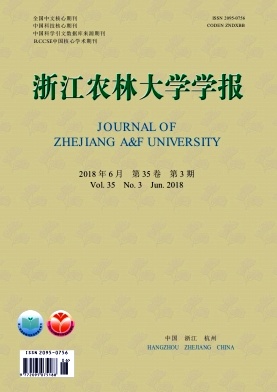-
嫁接是将一个植物体的枝及芽等部位接到同种或不同种植物体的适合部位,使二者接合形成一个新的植物体的技术,其中,被嫁接的部分称接穗,承担接穗的部分称砧木。嫁接作为一种广受欢迎的栽培技术,在世界各地受到广泛关注。嫁接在植物品种改良及繁殖方面应用普遍,在大豆Glycine max品种的遗传性状改良中,通过考虑根系性状来挑选合适砧木进行嫁接可以极大地增加籽粒产量,改善大豆品质[1]。不仅如此,嫁接可增强嫁接苗抵抗非生物和生物逆境(尤其是土传病害)能力,是一种重要的综合害虫管理策略技术,如用于治理土壤病原体和其他禾本科Gramineae和葫芦科Cucurbitaceae作物的害虫[2]。同时嫁接增加了植物的养分吸收及水分利用[3],在苹果Malus pumila嫁接研究中发现,利用选择优良砧木嫁接的技术手段可提升苹果的抗旱性,使其发挥更大的光化学效率及水分利用效率[4]。此外,大量研究认为,嫁接能够提高产量并改善果实品质[5-7];选择适合条件的砧木进行嫁接能够有效加强辣椒Capsicum annuum肉质厚度和坚实度等的果实品质[8];很多情况下,嫁接会与更多可持续的作物生产实践结合使用,包括降低许多国家的土壤熏蒸剂的使用率和总体使用量[9]。然而,嫁接苗的成活率是影响嫁接技术在生产中使用的一个非常重要因素。嫁接苗的成活与砧穗能否良好愈合息息相关。植物嫁接砧穗愈合是指同种或异种植物的细胞、组织或器官互相影响与作用结合成一个完整有机体的过程,不仅受温度、光照、湿度等外界因素影响,还与嫁接时砧穗之间的亲缘关系,发育阶段,亲和性及其内部生理与分子的调控有关。了解嫁接砧穗愈合机制对提高嫁接成活率和嫁接技术在生产中的应用具有重要意义。近年来,人们对嫁接认识逐渐从传统的组织学、细胞学、生理生化角度转为分子机制的探讨,并取得了许多重要的研究进展。本研究就砧穗愈合进程、生理与分子调控及影响因素方面的研究进展进行综述。
HTML
-
大量研究表明,嫁接愈合过程分成4个阶段,包括隔离层出现,愈伤组织形成,愈伤组织分裂、增殖、抱合、连接,形成层恢复和输导组织连接。
-
当接穗嫁接到砧木上时,砧穗之间的接合面上部分薄壁细胞受损,原生质发生凝结现象,在伤口表面形成了隔离层,外观为一层褐色的坏死组织。隔离层的形成可密封伤口使其不被病菌感染,并且能阻止有机物大量外渗,减少嫁接面水分蒸发。不同嫁接组合隔离层出现的时间也有一定的差异,如以黑籽南瓜Cucurbita ficifolia为砧木,以'津寒3号'黄瓜Cucumis sativus 'Jinhan 3'为接穗,隔离层在嫁接后1~2 d后出现[10],而以'青研1号'南瓜Cucurbita moschata'Qingyan 1'作砧木嫁接'津优35号'黄瓜Cucumis sativus 'Jinyou 35',3 d后出现隔离层[11]。
-
在隔离层形成同时,愈伤口周围的形成层衍生细胞、韧皮部及皮层、木质部薄壁细胞及髓部细胞等发生脱分化从而形成愈伤组织,其周围存在着残缺的隔离层。之后,愈伤组织细胞膨大且表现为高度液泡化,砧木与接穗的接合面会发生明显隆起[12]。由于愈伤组织的形成部位除了形成层之外还有髓部细胞等,因此对嫁接成活而言形成层并不是必需的。愈伤组织的形成能促使砧穗紧密结合,从而加速伤口愈合,此外也可分化出不定根和不定芽[11]。
-
愈伤组织的不断分裂,导致其体积不断扩增,砧穗间的空隙逐渐缩小,愈伤组织的薄壁细胞相互连接形成愈伤组织桥。隔离层随愈伤组织间的连接而消失。在输导系统连接前,愈伤组织桥负责运输接穗所需的水分和养分。一般情况下,愈伤组织桥形成越早,嫁接成活几率越大。
-
在愈伤组织桥的边缘,与砧穗间形成层相近的薄壁细胞会向内分化形成新的木质部,向外形成新的韧皮部,使导管与筛管及砧穗间的形成层连接起来,至此整个愈合过程基本结束。砧穗之间愈伤组织维管束桥的形成是嫁接成功的重要标志。研究表明,维管束桥的形成是西瓜Citrus lanatus嫁接苗成活的细胞学特征[13]。
1.1. 隔离层的形成
1.2. 愈伤组织的形成
1.3. 愈伤组织的分裂、增殖、抱合和连接
1.4. 形成层的恢复和输导组织的连接
-
在嫁接砧穗愈合进程中,内源激素通过影响物质运输及代谢过程等影响嫁接体成活。生长素(IAA)与嫁接成活率呈显著正相关,IAA在嫁接初期可诱导嫁接体产生大量愈伤组织,后期时可促进维管束分化[14],而脱落酸(ABA)则降低嫁接成活率[15]。同样有抑制作用的内源激素还有赤霉素(GA)和乙烯。GA会抑制维管束形成[16],乙烯可加速嫁接体老化[17],二者都不利于嫁接体成活。
-
可溶性蛋白质及丙二醛(MDA)是嫁接愈合过程中的重要生理指标。可溶性蛋白质是构成酶的重要组成部分,参与植物体内多种生理生化代谢过程的调控[18]。MDA是在植物处于逆境伤害或老化时,由组织或器官膜脂过氧化产生的[19],因此,可溶性蛋白质及MDA可在一定程度上描述植物在嫁接过程中的受损程度及代谢情况。大量研究证实,嫁接初期植物体内的可溶性蛋白质及MDA通常都会呈现上升趋势,如番茄Lycopersicon esculentum嫁接后的接穗中,两者均升高[20],陈红等[21]发现嫁接后各时期的可溶性蛋白质均明显高于自根苗。
-
酚类和单宁是嫁接成活的重要影响因素。酚类抗氧化性强,具有抗氧化及清除自由基的能力[22],同时还参与木质素的合成。单宁是化学组成较为复杂、具有鞣性的多元酚[23]。一般情况下,嫁接成活率随酚类及单宁含量的升高而降低。一方面,酚类的产生会降低砧穗间的亲和性,郭大勇等[24]在日本栗Castanea crenata与板栗Castanea mollissima的嫁接研究中发现砧穗间亲和力与酚类呈显著负相关;另一方面,酚类会与蛋白质作用生成不溶性聚合单宁,影响嫁接愈合,如马绍英等[25]认为单宁的含量与其嫁接亲和性呈显著负相关。
-
PPO参与木质素的合成,主要作用于嫁接愈合初期,其将砧穗接合部的酚类氧化成活性醌,醌聚集形成黑色和褐色的隔离层[26],但PPO过高也可使接合部愈伤组织发生褐化甚至坏死现象[27]。研究表明,嫁接后整体水平上PPO趋于平稳,一般为先上升后下降[28],通常在不亲和嫁接组合中PPO活性高且持续时间长[29],因此,PPO活性的高低既可以表明接穗木质化程度,又可以为嫁接植物砧穗间的亲和性判断提供参考。
-
在嫁接愈合过程中,PAL促进细胞分化及木质化,是嫁接植物功能重建及组织发育的重要因子。在嫁接后PAL活性基本呈上升趋势,创伤口的PAL高于嫁接口,这说明随着嫁接时间的延长创伤口的木质化程度高于嫁接口。PAL在一定程度上也可描述嫁接的亲和性,如PAL活性最高值较高的“鸭梨Pyrus bretschneideri/豆梨Pyrus calleryana”组合的亲和性高,而该值较低的“OHF51/豆梨”组合亲和性也较低[30]。
-
CAD是影响木质素合成的关键酶,且仅应用于木质素合成中[31],因而变化规律与木质素相似。木质素是嫁接口维管组织分化的前提,在嫁接砧穗愈合过程中影响重大。张淑红等[28]在对嫁接后14 d内的CAD活性以及木质素研究后发现,自根苗创伤口比嫁接口木质素含量高,有益于伤口愈合。
-
在砧穗愈合过程中,作为植物抗氧化防御系统的超氧化物歧化酶(SOD)、过氧化物酶(POD)、过氧化氢酶(CAT)发挥着重要作用[32]。SOD能够清除超氧阴离子,是生物体抗氧化系统的第一道防线,POD参与一些蛋白质分子的交联反应和细胞壁多糖间的连结,CAT可分解由其他部分产生的过氧化氢(H2O2)。嫁接初期,POD,SOD的活性逐渐增加,可清除自由基并抑制膜脂过氧化,维护膜的结构及功能,后期随着嫁接接口的愈合,其活性逐渐下降,CAT活性与此相反,表现出先降后增的趋势[21]。嫁接体不同部位的3种酶活性也有一定差异,在油茶Camellia oleifera芽苗砧嫁接愈合过程中,砧木POD活性高于接穗[33],在黄瓜嫁接研究中,嫁接苗愈合面SOD,POD和CAT的活性均高于砧木和接穗[10]。
-
同工酶的表达在一定程度上为嫁接愈合提供参考。嫁接会引起砧木及接穗中的同工酶带发生变化[34],接穗与砧木的同工酶谱的相似系数越高,其嫁接的亲和性越强,越容易成活,西瓜与冬瓜Benincasa hispida,葫芦Lagenaria siceraria等同工酶谱相似,所以更易成活[35],同样在番茄与茄子Solanum melongena嫁接的研究中发现接穗番茄品种'申粉918''Shenfen 918'与砧木茄子'72号''No. 72'的POD和SOD的同工酶相似系数较高,亲和性也较好[36]。
2.1. 植物内源激素含量的变化
2.2. 可溶性蛋白质及丙二醛(MDA)的变化
2.3. 酚类及单宁的变化
2.4. 与木质素合成密切相关酶类物质的量和种类
2.4.1. 多酚氧化酶(PPO)的变化
2.4.2. 苯丙氨酸解氨酶(PAL)的变化
2.4.3. 肉桂醇脱氢酶(CAD)及木质素的变化
2.5. 抗氧化保护酶活性及同工酶表达
2.5.1. 抗氧化保护酶对嫁接愈合过程的影响
2.5.2. 同工酶的表达
-
嫁接愈合过程受到基因的调控,基因的沉默或表达参与嫁接进程。冯金玲等[37]对油茶芽苗砧嫁接口在愈合过程中扩增片段长度多态性(AFLP)的条带数进行分析,结果表明嫁接过程中基因出现变化。在对拟南芥Arabidopsis thaliana嫁接24 h后的组织学和转录水平上进行的研究中也有此结论[38]。基因参与嫁接过程主要表现为与嫁接相关基因出现及上调,如在山核桃Carya cathayensis嫁接后0,7,14 d等3个独立的cDNA测序中,发现了大量差异表达基因[39]。此外,在嫁接愈合过程中与裂解酶、水解酶及氧化还原酶等活性相关的基因上调,激活乙烯和茉莉酸的生物合成,从而参与隔离层的分解、维管束的连接等[38]。在葡萄Vitis vinifera嫁接后3 d和28 d的砧木和接穗的转录组研究中发现,在个体基因水平上,接种后3 d砧穗愈合面组织中52个基因被特异性上调,包括许多与激素信号相关的基因,例如细胞分裂素和茉莉酸信号,次级代谢,非生物胁迫和受体激酶相关基因等,其中与韧皮部发育及蛋白质降解相关的基因表现为显著上调。同时,嫁接砧穗接合处出现的特异性基因会随着时间的延长参与嫁接体的一系列生理活动,如接合处与衰老相关基因参与细胞次生代谢、细胞壁的合成、木质部和韧皮部连接等过程[40],参与细胞间的信号传递,从而调控酶的表达,影响嫁接植物的开花结果及品质等[41],如嫁接后可开花基因型的砧木会传递开花刺激信号至不开花基因型的接穗从而有助于接穗开花等[42]。
-
miRNA是一类参与转录后基因调控的内源性非编码小RNA,在植物生长,发育和胁迫反应中起关键作用。在嫁接愈合中,miRNA的表达同样有重要意义。在对西瓜嫁接后全基因组范围的miRNA的研究发现,与自嫁接相比,西瓜嫁接到葫芦和南瓜上的miRNA表达明显不同[43],但作用机制还有待进一步研究。
-
YEOMAN等[44]首次提出“嫁接蛋白”(grafting protein)的概念,并假设此蛋白可促使砧穗愈合。曾义安等[45]发现,在黄瓜嫁接中出现了1~2种特异性蛋白,对黄瓜嫁接苗和自根苗的蛋白质组学研究中发现嫁接苗叶片中新产生了4种蛋白:提高抗病抗逆能力的R蛋白(RGC693蛋白),促进萜烯类物质合成的鲨烯合酶,促进叶绿体合成的辅酶和提高光能利用率的捕光叶绿素a/b结合蛋白;在黄瓜/南瓜组合嫁接植物叶片蛋白质组表达变化的研究中发现,嫁接愈合良好的组合中涉及光合作用,碳水化合物和能量代谢及蛋白质代谢相关蛋白表达程度高[46-47]。除此之外,冯金玲等[48]在油茶芽苗砧嫁接的蛋白质组学研究中也确定了9个与嫁接愈合相关的蛋白。
3.1. 基因的变化
3.2. miRNA调控
3.3. 特异性蛋白的出现
-
接穗苗龄对于嫁接苗的愈合及成活有重要影响,不同植物适宜嫁接的接穗苗龄也不尽相同,如茄果类蔬菜接穗用苗龄一般不应超过4叶期,以第2~3片真叶展开为宜。当接穗苗龄较小时,位于接穗切面上的未分化的幼嫩细胞、分生组织及薄壁细胞具有较高的再生能力,而接穗苗龄较大时,细胞分裂能力逐渐降低,且部分细胞己经开始分化,导致愈合面两侧的砧木和接穗细胞无法突破隔离层,从而影响砧穗愈合[49]。山核桃Carya cathayensis嫁接体发育过程中,接穗苗龄较小的3个嫁接组合中的隔离层附近细胞内的细胞器较为丰富,它们参与嫁接体的代谢过程[50]。西瓜接穗苗龄低于10 d时,嫁接愈合快,嫁接苗成活率达90%以上;而接穗苗龄为13 d和18 d的嫁接组合在嫁接8 d后愈合面隔离层仍存在,嫁接苗成活率分别为83.3%和72%[13]。在嫁接过程中,砧木活力越高,嫁接成活率越高[51],如高活力砧木品种南瓜'京欣砧5号'Cucurbita moschata'Jingxinzhen No. 5'具有根系发达,吸肥力强等特征,嫁接黄瓜成活率高[52],适合西瓜嫁接的高活力砧木葫芦'鄂砧1号'Lagenaria siceraria'E-zhen No. 1'嫁接后易愈合,嫁接苗成活率高[53]。
-
嫁接砧穗愈合的过程中亲和性决定了嫁接是否能顺利进行,砧穗之间亲和性越好,接合面越容易愈合,从而使植株更易吸收水分及养分,进而促进伤口愈合,增加嫁接植株的成活率。同种植物由于砧木与接穗亲缘关系近,嫁接亲和性强,成活率显著高于异种植物,如野生非洲红茄Solanum integrifolium作砧木嫁接番茄的亲和性较好[54],水茄Solanum torvum作为砧木嫁接茄子亲和力高,嫁接成活率高达92%[55]。不同种植物之间,亲缘关系与亲和性呈显著正相关,如亲缘关系较近的'鸭梨/豆梨'组合愈合良好,恢复生长迅速[30],而亲缘关系较远的番茄与胡椒组合的嫁接成活率很低[56]。也有研究发现亲缘关系较远的组合,如以化香Platycarya strobilacea作砧木,嫁接山核桃时成活率高达90%以上,其原因可能为作为砧木的化香根部再生能力强,嫁接后取苗断根栽植易生成新根,且化香有春季萌芽早的优势,然而以化香作砧木嫁接山核桃存在后期保存率较低及亲和性较差的现象,因此,具体应用时还需综合考量[57-58]。
-
光作为光合作用、激素调节和某些信号通路的能量来源,可促进木质部和韧皮部的维管连接,对嫁接过程中的砧穗愈合有积极影响[59],适宜的光强及光质对嫁接愈合有促进作用[60],如在嫁接后用发光二极管(LED)作为光源并结合不同的波长组合有助于伤口愈合期间砧穗维管束的连接及秧苗的气孔保护[3],同时,在应用时需提供足够数量和质量的光,因此,建议在生产实践活动中添加不同LED组合,特别是红色,蓝色和白色的LED组合,该组合能提供适宜嫁接植物愈合生长的光强和光质[61]。
-
嫁接苗的愈合与愈合期的温度关系密切,适宜的温度条件有利于嫁接苗愈合。在适宜温度范围内,温度与嫁接成活率呈极显著正相关,适当提高温度有助于促进愈伤组织形成,加速伤口愈合[62]。与此同时,变温环境下愈伤组织分化成芽的数量增多,有利于生根及壮苗培养[63]。此外,由于叶片积累的光合产物运输主要在夜间进行,夜温对嫁接愈合也有显著影响[64],如夜温16 ℃为番茄嫁接苗愈合的最适温度[65]。在日常生产生活中,自然条件下控制嫁接苗愈合期的温度是较为困难的,因此,可利用设施条件来改善,如生产中常用到小拱棚等,通过增设地热线即可满足嫁接苗愈合期间对温度的要求[66]。
-
湿度控制是嫁接愈合管理中重要部分,越来越多的研究致力于如何高效控制嫁接期湿度,在嫁接初期,由于经受极端水分胁迫,接穗在愈合期开始1~4 d气孔导度降低到几乎为零,严重枯萎[67],为保证接穗不发生萎蔫失水,嫁接过程中特别要注意环境湿度。在常规培养中,嫁接后常覆膜以减少水分蒸发,保持适宜的环境湿度[5]。通常愈合期处于高相对湿度(≥95%)下时,嫁接植物能顺利存活[68],在愈合期结束时嫁接植物含水量与未嫁接前植物含水量相当[67],这也证实了嫁接愈合期湿度管理的重要性。
-
大量研究发现,在植物嫁接愈合期间加入一定量的外源植物生长调节剂会对接合部的愈合产生有益效果,加速嫁接砧穗愈合,如使用细胞激动素药剂处理嫁接苗,可显著缩短愈合时间,促进接穗生长并有利于嵌合体愈合[69],其他外源植物生长调节剂如一定质量浓度的二氯苯氧乙酸、生根粉6号(ABT6)、吲哚丁酸(IBA)、萘乙酸(NAA)等均对嫁接植物成活有促进作用[70-71]。
4.1. 内在因素对嫁接砧穗愈合的影响
4.1.1. 接穗苗龄与砧木活力
4.1.2. 砧木与接穗的亲和性
4.2. 外在因素对嫁接砧穗愈合的影响
4.2.1. 光
4.2.2. 温度
4.2.3. 湿度
4.3. 外源植物生长调节剂
-
嫁接作为一种栽培技术因其实用价值而受到广泛青睐。近年来,人们对嫁接愈合过程的形态学研究及影响因子等有了系统认识,但对于一些具体的分子机制研究还不成熟,如接穗与砧木之间的相互作用对接合部位愈合及维管系统重建的驱动机制,接合部位特异性基因及信号传导对嫁接愈合的调控机制等方面,因此,分子调控仍是未来重要的研究领域。嫁接作为一种重要的技术手段,不仅处于单一的园艺学科领域,更是一项跨学科的综合研究,未来在嫁接愈合过程的理论指导,经济环境资源利用,嫁接相关工具更新,系统工程调控等方面将会有更为深远的进步。






 DownLoad:
DownLoad: